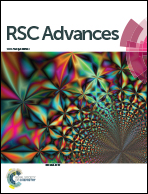Effect of niobium doping on the microstructure and electrochemical properties of lithium-rich layered Li[Li0.2Ni0.2Mn0.6]O2 as cathode materials for lithium ion batteries
Abstract
Niobium-doped lithium-rich layered cathode materials, Li[Li0.2Ni0.2Mn0.6−xNbx]O2 (x = 0, 0.02, 0.04, and 0.06), were prepared and the effects of Nb doping on the microstructure and electrochemical properties were investigated. Upon Nb doping, the layered α-NaFeO2 structure is maintained but with an expanded interlayer spacing and the electrochemical properties are significantly enhanced. In particular, the sample with x = 0.04 delivers a large reversible discharge capacity of 254 mA h g−1 at 0.1 C rate with a high capacity retention rate of 92.3% after 100 cycles. Furthermore, it delivers 198 mA h g−1 at 1 C rate, much larger than that of the undoped sample (125 mA h g−1). Capacity differential results reveal that strong Nb–O bond can stabilize the material structure and thus lead to a stable cycling performance. Electrochemical impedance spectroscopy (EIS) analysis shows that Nb doping can decrease the whole cell impedance and expand the Li+ diffusion path in the lithium-rich layered cathode materials, resulting in the excellent rate capability.
![Graphical abstract: Effect of niobium doping on the microstructure and electrochemical properties of lithium-rich layered Li[Li0.2Ni0.2Mn0.6]O2 as cathode materials for lithium ion batteries](/en/Image/Get?imageInfo.ImageType=GA&imageInfo.ImageIdentifier.ManuscriptID=C5RA01798J&imageInfo.ImageIdentifier.Year=2015)

 Please wait while we load your content...
Please wait while we load your content...